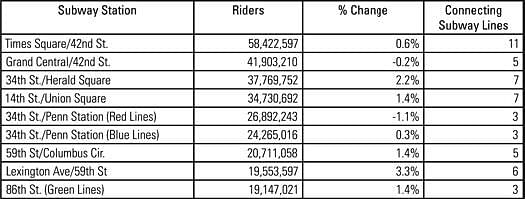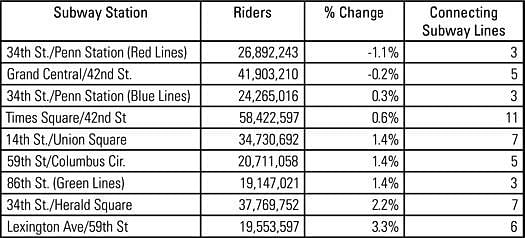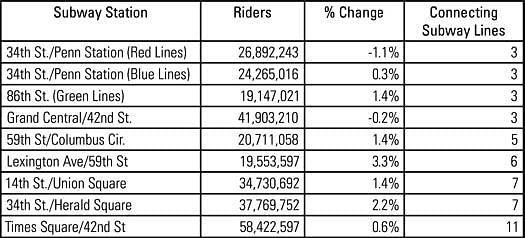GMAT Exam > GMAT Questions > The table below gives information for the yea...
Start Learning for Free
The table below gives information for the year 2010 on the ridership in 9 subway stations in New York City. The subway stations were chosen for inclusion in the table because they were the busiest stations in 2010, based on the number of passengers entering the station. In addition to annual ridership (number of passengers) for each station in 2010, the table also gives the percent increase or decrease in ridership from 2009 to 2010 and the number of subway lines that connect to the station.

Each column of the table can be sorted in ascending order by clicking on the word “Select” above the table and choosing, from the dropdown menu, the heading of the column on which you want the table to be sorted.
Alternate Sort 1: % Change

Alternate Sort 2: Connecting Subway Lines

Consider each of the following statements about this Presidential election data. For each statement indicate whether the statement is true or false, based on the information provided in the table.
Q. The station with the highest percent increase in riders from 2009 to 2010 had the lowest annual ridership in
2010.
2010.
- a)True
- b)False
Correct answer is option 'B'. Can you explain this answer?
Most Upvoted Answer
The table below gives information for the year 2010 on the ridership i...
Sorting the table by % Change will make it easy to identify the station with the highest percent increase in riders from 2009 to 2010: Lexington Ave/59th Street. However, when the table is sorted by Riders, Lexington Ave/59th Street is 8th, not 9th (last), in annual ridership, and so the statement is false.
Attention GMAT Students!
To make sure you are not studying endlessly, EduRev has designed GMAT study material, with Structured Courses, Videos, & Test Series. Plus get personalized analysis, doubt solving and improvement plans to achieve a great score in GMAT.

|
Explore Courses for GMAT exam
|

|
The table below gives information for the year 2010 on the ridership in 9 subway stations in New York City. The subway stations were chosen for inclusion in the table because they were the busiest stations in 2010, based on the number of passengers entering the station. In addition to annual ridership (number of passengers) for each station in 2010, the table also gives the percent increase or decrease in ridership from 2009 to 2010 and the number of subway lines that connect to the station.Each column of the table can be sorted in ascending order by clicking on the word “Select” above the table and choosing, from the dropdown menu, the heading of the column on which you want the table to be sorted.Alternate Sort 1: % ChangeAlternate Sort 2: Connecting Subway LinesConsider each of the following statements about this Presidential election data. For each statement indicate whether the statement is true or false, based on the information provided in the table.Q.The station with the highest percent increase in ridersfrom 2009 to 2010 had the lowest annual ridership in2010.a)Trueb)FalseCorrect answer is option 'B'. Can you explain this answer?
Question Description
The table below gives information for the year 2010 on the ridership in 9 subway stations in New York City. The subway stations were chosen for inclusion in the table because they were the busiest stations in 2010, based on the number of passengers entering the station. In addition to annual ridership (number of passengers) for each station in 2010, the table also gives the percent increase or decrease in ridership from 2009 to 2010 and the number of subway lines that connect to the station.Each column of the table can be sorted in ascending order by clicking on the word “Select” above the table and choosing, from the dropdown menu, the heading of the column on which you want the table to be sorted.Alternate Sort 1: % ChangeAlternate Sort 2: Connecting Subway LinesConsider each of the following statements about this Presidential election data. For each statement indicate whether the statement is true or false, based on the information provided in the table.Q.The station with the highest percent increase in ridersfrom 2009 to 2010 had the lowest annual ridership in2010.a)Trueb)FalseCorrect answer is option 'B'. Can you explain this answer? for GMAT 2024 is part of GMAT preparation. The Question and answers have been prepared according to the GMAT exam syllabus. Information about The table below gives information for the year 2010 on the ridership in 9 subway stations in New York City. The subway stations were chosen for inclusion in the table because they were the busiest stations in 2010, based on the number of passengers entering the station. In addition to annual ridership (number of passengers) for each station in 2010, the table also gives the percent increase or decrease in ridership from 2009 to 2010 and the number of subway lines that connect to the station.Each column of the table can be sorted in ascending order by clicking on the word “Select” above the table and choosing, from the dropdown menu, the heading of the column on which you want the table to be sorted.Alternate Sort 1: % ChangeAlternate Sort 2: Connecting Subway LinesConsider each of the following statements about this Presidential election data. For each statement indicate whether the statement is true or false, based on the information provided in the table.Q.The station with the highest percent increase in ridersfrom 2009 to 2010 had the lowest annual ridership in2010.a)Trueb)FalseCorrect answer is option 'B'. Can you explain this answer? covers all topics & solutions for GMAT 2024 Exam. Find important definitions, questions, meanings, examples, exercises and tests below for The table below gives information for the year 2010 on the ridership in 9 subway stations in New York City. The subway stations were chosen for inclusion in the table because they were the busiest stations in 2010, based on the number of passengers entering the station. In addition to annual ridership (number of passengers) for each station in 2010, the table also gives the percent increase or decrease in ridership from 2009 to 2010 and the number of subway lines that connect to the station.Each column of the table can be sorted in ascending order by clicking on the word “Select” above the table and choosing, from the dropdown menu, the heading of the column on which you want the table to be sorted.Alternate Sort 1: % ChangeAlternate Sort 2: Connecting Subway LinesConsider each of the following statements about this Presidential election data. For each statement indicate whether the statement is true or false, based on the information provided in the table.Q.The station with the highest percent increase in ridersfrom 2009 to 2010 had the lowest annual ridership in2010.a)Trueb)FalseCorrect answer is option 'B'. Can you explain this answer?.
The table below gives information for the year 2010 on the ridership in 9 subway stations in New York City. The subway stations were chosen for inclusion in the table because they were the busiest stations in 2010, based on the number of passengers entering the station. In addition to annual ridership (number of passengers) for each station in 2010, the table also gives the percent increase or decrease in ridership from 2009 to 2010 and the number of subway lines that connect to the station.Each column of the table can be sorted in ascending order by clicking on the word “Select” above the table and choosing, from the dropdown menu, the heading of the column on which you want the table to be sorted.Alternate Sort 1: % ChangeAlternate Sort 2: Connecting Subway LinesConsider each of the following statements about this Presidential election data. For each statement indicate whether the statement is true or false, based on the information provided in the table.Q.The station with the highest percent increase in ridersfrom 2009 to 2010 had the lowest annual ridership in2010.a)Trueb)FalseCorrect answer is option 'B'. Can you explain this answer? for GMAT 2024 is part of GMAT preparation. The Question and answers have been prepared according to the GMAT exam syllabus. Information about The table below gives information for the year 2010 on the ridership in 9 subway stations in New York City. The subway stations were chosen for inclusion in the table because they were the busiest stations in 2010, based on the number of passengers entering the station. In addition to annual ridership (number of passengers) for each station in 2010, the table also gives the percent increase or decrease in ridership from 2009 to 2010 and the number of subway lines that connect to the station.Each column of the table can be sorted in ascending order by clicking on the word “Select” above the table and choosing, from the dropdown menu, the heading of the column on which you want the table to be sorted.Alternate Sort 1: % ChangeAlternate Sort 2: Connecting Subway LinesConsider each of the following statements about this Presidential election data. For each statement indicate whether the statement is true or false, based on the information provided in the table.Q.The station with the highest percent increase in ridersfrom 2009 to 2010 had the lowest annual ridership in2010.a)Trueb)FalseCorrect answer is option 'B'. Can you explain this answer? covers all topics & solutions for GMAT 2024 Exam. Find important definitions, questions, meanings, examples, exercises and tests below for The table below gives information for the year 2010 on the ridership in 9 subway stations in New York City. The subway stations were chosen for inclusion in the table because they were the busiest stations in 2010, based on the number of passengers entering the station. In addition to annual ridership (number of passengers) for each station in 2010, the table also gives the percent increase or decrease in ridership from 2009 to 2010 and the number of subway lines that connect to the station.Each column of the table can be sorted in ascending order by clicking on the word “Select” above the table and choosing, from the dropdown menu, the heading of the column on which you want the table to be sorted.Alternate Sort 1: % ChangeAlternate Sort 2: Connecting Subway LinesConsider each of the following statements about this Presidential election data. For each statement indicate whether the statement is true or false, based on the information provided in the table.Q.The station with the highest percent increase in ridersfrom 2009 to 2010 had the lowest annual ridership in2010.a)Trueb)FalseCorrect answer is option 'B'. Can you explain this answer?.
Solutions for The table below gives information for the year 2010 on the ridership in 9 subway stations in New York City. The subway stations were chosen for inclusion in the table because they were the busiest stations in 2010, based on the number of passengers entering the station. In addition to annual ridership (number of passengers) for each station in 2010, the table also gives the percent increase or decrease in ridership from 2009 to 2010 and the number of subway lines that connect to the station.Each column of the table can be sorted in ascending order by clicking on the word “Select” above the table and choosing, from the dropdown menu, the heading of the column on which you want the table to be sorted.Alternate Sort 1: % ChangeAlternate Sort 2: Connecting Subway LinesConsider each of the following statements about this Presidential election data. For each statement indicate whether the statement is true or false, based on the information provided in the table.Q.The station with the highest percent increase in ridersfrom 2009 to 2010 had the lowest annual ridership in2010.a)Trueb)FalseCorrect answer is option 'B'. Can you explain this answer? in English & in Hindi are available as part of our courses for GMAT.
Download more important topics, notes, lectures and mock test series for GMAT Exam by signing up for free.
Here you can find the meaning of The table below gives information for the year 2010 on the ridership in 9 subway stations in New York City. The subway stations were chosen for inclusion in the table because they were the busiest stations in 2010, based on the number of passengers entering the station. In addition to annual ridership (number of passengers) for each station in 2010, the table also gives the percent increase or decrease in ridership from 2009 to 2010 and the number of subway lines that connect to the station.Each column of the table can be sorted in ascending order by clicking on the word “Select” above the table and choosing, from the dropdown menu, the heading of the column on which you want the table to be sorted.Alternate Sort 1: % ChangeAlternate Sort 2: Connecting Subway LinesConsider each of the following statements about this Presidential election data. For each statement indicate whether the statement is true or false, based on the information provided in the table.Q.The station with the highest percent increase in ridersfrom 2009 to 2010 had the lowest annual ridership in2010.a)Trueb)FalseCorrect answer is option 'B'. Can you explain this answer? defined & explained in the simplest way possible. Besides giving the explanation of
The table below gives information for the year 2010 on the ridership in 9 subway stations in New York City. The subway stations were chosen for inclusion in the table because they were the busiest stations in 2010, based on the number of passengers entering the station. In addition to annual ridership (number of passengers) for each station in 2010, the table also gives the percent increase or decrease in ridership from 2009 to 2010 and the number of subway lines that connect to the station.Each column of the table can be sorted in ascending order by clicking on the word “Select” above the table and choosing, from the dropdown menu, the heading of the column on which you want the table to be sorted.Alternate Sort 1: % ChangeAlternate Sort 2: Connecting Subway LinesConsider each of the following statements about this Presidential election data. For each statement indicate whether the statement is true or false, based on the information provided in the table.Q.The station with the highest percent increase in ridersfrom 2009 to 2010 had the lowest annual ridership in2010.a)Trueb)FalseCorrect answer is option 'B'. Can you explain this answer?, a detailed solution for The table below gives information for the year 2010 on the ridership in 9 subway stations in New York City. The subway stations were chosen for inclusion in the table because they were the busiest stations in 2010, based on the number of passengers entering the station. In addition to annual ridership (number of passengers) for each station in 2010, the table also gives the percent increase or decrease in ridership from 2009 to 2010 and the number of subway lines that connect to the station.Each column of the table can be sorted in ascending order by clicking on the word “Select” above the table and choosing, from the dropdown menu, the heading of the column on which you want the table to be sorted.Alternate Sort 1: % ChangeAlternate Sort 2: Connecting Subway LinesConsider each of the following statements about this Presidential election data. For each statement indicate whether the statement is true or false, based on the information provided in the table.Q.The station with the highest percent increase in ridersfrom 2009 to 2010 had the lowest annual ridership in2010.a)Trueb)FalseCorrect answer is option 'B'. Can you explain this answer? has been provided alongside types of The table below gives information for the year 2010 on the ridership in 9 subway stations in New York City. The subway stations were chosen for inclusion in the table because they were the busiest stations in 2010, based on the number of passengers entering the station. In addition to annual ridership (number of passengers) for each station in 2010, the table also gives the percent increase or decrease in ridership from 2009 to 2010 and the number of subway lines that connect to the station.Each column of the table can be sorted in ascending order by clicking on the word “Select” above the table and choosing, from the dropdown menu, the heading of the column on which you want the table to be sorted.Alternate Sort 1: % ChangeAlternate Sort 2: Connecting Subway LinesConsider each of the following statements about this Presidential election data. For each statement indicate whether the statement is true or false, based on the information provided in the table.Q.The station with the highest percent increase in ridersfrom 2009 to 2010 had the lowest annual ridership in2010.a)Trueb)FalseCorrect answer is option 'B'. Can you explain this answer? theory, EduRev gives you an
ample number of questions to practice The table below gives information for the year 2010 on the ridership in 9 subway stations in New York City. The subway stations were chosen for inclusion in the table because they were the busiest stations in 2010, based on the number of passengers entering the station. In addition to annual ridership (number of passengers) for each station in 2010, the table also gives the percent increase or decrease in ridership from 2009 to 2010 and the number of subway lines that connect to the station.Each column of the table can be sorted in ascending order by clicking on the word “Select” above the table and choosing, from the dropdown menu, the heading of the column on which you want the table to be sorted.Alternate Sort 1: % ChangeAlternate Sort 2: Connecting Subway LinesConsider each of the following statements about this Presidential election data. For each statement indicate whether the statement is true or false, based on the information provided in the table.Q.The station with the highest percent increase in ridersfrom 2009 to 2010 had the lowest annual ridership in2010.a)Trueb)FalseCorrect answer is option 'B'. Can you explain this answer? tests, examples and also practice GMAT tests.

|
Explore Courses for GMAT exam
|

|
Suggested Free Tests
Signup for Free!
Signup to see your scores go up within 7 days! Learn & Practice with 1000+ FREE Notes, Videos & Tests.























